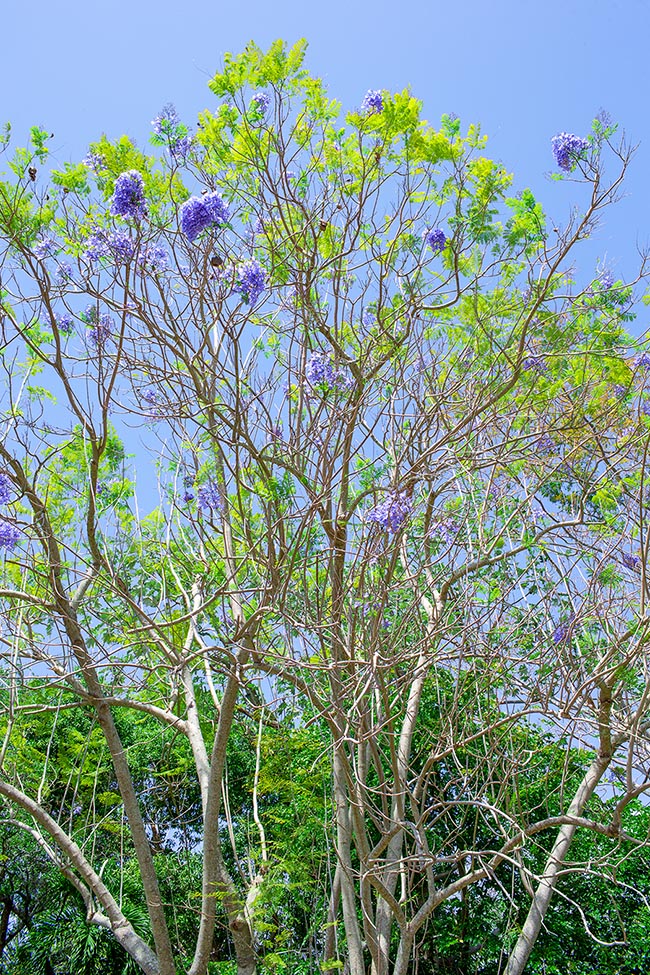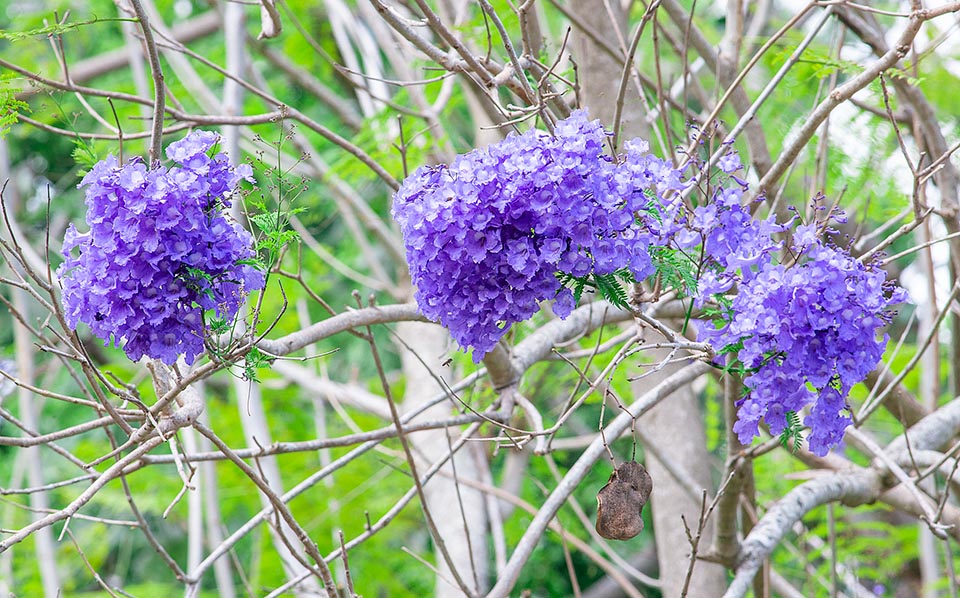Family : Bignoniaceae

Text © Pietro Puccio

English translation by Mario Beltramini
The species is native to north-western Argentina, Bolivia, Brazil (Goiás, Mato Grosso, Mato Grosso do Sul, Minas Gerais and Sao Paulo) and Paraguay where it lives in the semi-deciduous forests and the savannahs, on mainly rocky soils, from the sea level up to about 1500 m of altitude.
The name of the genus comes from the Tupi-Guarani of this species: “jakara’nda” = fragrant; the specific name is the combination of the Latin substantives “cuspis, idis” = cuspid and “folium, ii” = leaf, with reference to the acuminate apex of the leaflets.
Common names: blue jacaranda, cuspidateleaf jacaranda, cuspid jacaranda, purple fern tree, toothleaf jacaranda (English); carobá, paraparay, paraparay guazú (Argentina); paraparaú, paypacu (Bolivia); flamboyant bleu (French); caiuá, caroba, caroba-branca, carobeira, jacarandá, jacarandá-branco, jacarandá-de-minas, jacarandá preto, mulher pobre, parapara-í, paraparaí, pau de colher, pau santo (Brazil).

Native to South American Jacaranda cuspidifolia is a deciduous tree that can reach in nature the 20 m of height with a trunk of 40 cm of diameter having wrinkled brown greyish bark tending to flake off with the age © Giuseppe Mazza
The Jacaranda cuspidifolia Mart. (1841) is a deciduous tree, 4-8 m tall that in the old specimens in nature may reach the 20 m, with trunk, of up to about 40 cm of diameter, with wrinkled bark, brown greyish tending to flake off with the age.
Leaves, on a 4-8 cm long petiole, bipinnate, 20-50 cm long, with winged rachis grooved above and 8-13 couples of imparipinnate leaflets, 10-18 cm long, formed by 10-16 couples of sessile lanceolate leaflets with acuminate apex and entire margin of intense green colour, 1-2,5 cm long and 0,4-0,7 cm broad, with falciform terminal leaf, 2-3 cm long and 0,6-0,8 cm broad.
Panicle terminal inflorescence, globose, 18-32 cm long, formed by numerous flowers, on a 0,6-0,8 cm long pedicel, hermaphrodite, slightly fragrant, with calyx, about 0,5 cm long, formed by 5 subulate sepals with acuminate apex merged at the base.
Campanulate-infundibuliform corolla with 5 rounded lobes, 5-6 cm long and of 3,4-4 cm of diameter, with purplish cerulean to purplish blue with a white dot inside, slightly pubescent externally.
The fruit is an ovate capsule with wavy margin, 7-10 cm long, 5-7 cm broad and 4 cm thick, woody, of pale brown colour, containing numerous seeds of brown colour with chartaceous wing, of about 1,5 cm of diameter.
It propagates by seed, that has a short-lasting germinability (few months), previously kept in water for two days, placed superficially in draining organic loam maintained humid at the temperature of 24-26 °C, with germination times, of 2-4 weeks, with averagely fast growth and first blooming starting from 5-6 years of age; it can reproduce also by cutting.
Species of great ornamental and landscape value as isolated specimen, in group or in rows at the borders of roads and alleys, similar to the most famous and diffused in cultivation Jacaranda mimosifolia, but with more compact inflorescences and slightly darker and bigger flowers, it blooms profusely in spring, by the vegetative restart, occasionally in summer.
Cultivable in the tropical subtropical and warm temperate climate regions, where, when adult, it can bear temperatures up to about -4 °C for short period, but blooms at the best in the climates characterized by cool and little rainy winters.

Globose panicle terminal inflorescences of 18-32 cm with purplish cerulean or purplish blue corollas, ornate inside by a white dot. The fruit, visible below, is a woody ovate capsule with wavy margin with numerous brown seeds entrusted to the wind. Bark and leaves have interesting antimicrobial properties for the official pharmacopoeia © Giuseppe Mazza
It requires full sun, except during the first phases of growth when it is preferable a slight shade, and is not particular about the soil, provided draining, slightly acidic to slightly alkaline, and well rooted it bears dry periods. It is a subject of sure interest to cultivate as bonsai.
Bark and leaves are utilized in the traditional medicine, in particular for treating venereal diseases, laboratory studies have evidenced the presence in various parts of the plant of bioactive substances with antimicrobial activity for the official pharmacopoeia. The wood, of decent quality, has a modest employment at local level in carpentry.
Synonyms: Jacaranda cuspidifolia var. calycina Bureau (1897); Jacaranda chapadensis Barb. Rodr. (1902).
